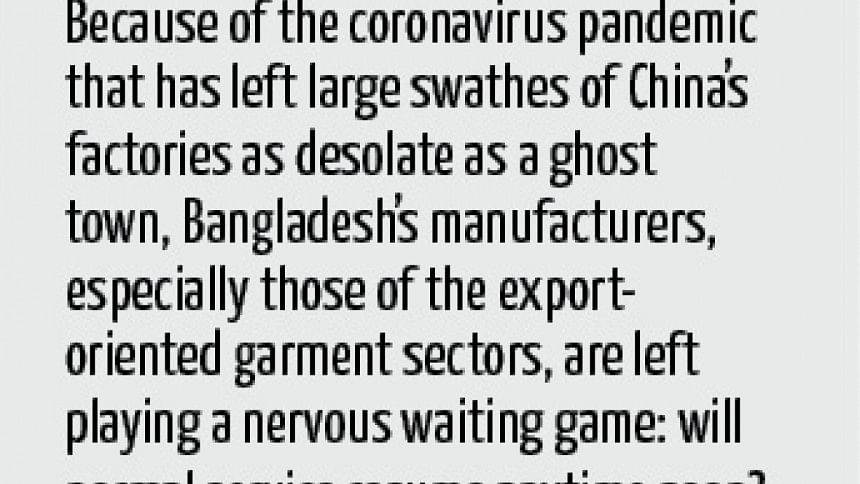Coronavirus Outbreak In China: Manufacturers feel the sting

It's not wise to put all your eggs in one basket, goes the age-old saying. And this saying could not be more pertinent given the jittery state of global supply chain following the outbreak of coronavirus in China.
China's comparative advantage in manufacturing relatively simple, low-value products like clothing and plastic goods to more advanced and lucrative pursuits like smartphones, computers and auto parts is peerless.
Which is why, it has gone on to become the world's largest manufacturer, accounting for roughly one-sixth of global economic output.
Almost all the nations have become excessively reliant -- and sometimes exclusively -- on it for their material needs. And Bangladesh is no different.
The country imports the most from China, starting from the simplest needle to high-tech capital machinery, industrial raw materials to finished consumer goods and foodstuff.
Last fiscal year, about 26 percent of Bangladesh's imports worth $52.19 billion came from China, according to the central bank's country and commodity wise import data. A year earlier, the share of imports from China was 23.8 percent.
But now, because of the coronavirus pandemic that has left large swathes of China's factories as desolate as a ghost town, Bangladesh's manufacturers, especially those of the export-oriented garment sectors, are left playing a nervous waiting game: will normal service resume anytime soon?
"Nobody is saying that there will be no deliveries, but nobody is saying when they will be either," said MA Jabbar, managing director of DBL Group, a major garment exporter.
Given the tight deadlines that garment exporters work with, Jabbar's firm went on a mad dash to manage sourcing alternatives as news emerged towards the end of last month of the lethal, pneumonialike virus spreading like wildfire across China, the world's most populous nation, and at least two dozen other countries.
So uncontrollable the novel virus has become that Xi Jinping's government extended the bank holidays for Lunar New Year, the most important festival of the year in China, by nine days to February 9 in a bid to keep people home and halt its spread.
The fear of the virus, which has already claimed more lives than the lethal Sars epidemic that tore through more than two dozen countries including China between November 2002 and April 2003, is so widespread and intense that many workers are likely to remain away from factory towns for weeks.
At the time of writing, the overall death toll from COVID-19, as the disease has been named, crossed 1,300.
For an order DBL Group is currently working on, it is bringing in the fibre from Austria by paying more, and chemicals and dyes from India.
But the final flourish on the products in the work order is a specific trim that can only be procured from China.
"The trims were developed in consultation with us by Chinese factories," Jabbar said, adding that he is hopeful that his supplier in China would be shipping it within a fortnight or two.
DBL Group's predicament is emblematic of the integral role China has carved for itself in the global economy in this millennium, producing components needed by auto factories in the American Midwest and Mexico to apparel plants in Bangladesh and Turkey.
Moniruzzaman, director of Bonian Knit Fashions, is less calm than Jabbar.
The fabric for the order worth $60,000 that his factory in Kashimpur, Gazipur is working on was supposed to arrive from a textile mill in China's Zhejiang province on April 20.
But that textile mill has been a vacuum since the Lunar New Year on January 24, so he is worrying that the fabric will not show up on time.
Chinese factories take 15-20 days to manufacture the fabric once they get the order. After that, it takes a fortnight by ship for the fabric to arrive in Bangladesh. Once in Bangladesh territory, it takes another week for the consignment to get customs clearance, according to Moniruzzaman.
"I don't know yet whether the European buyer will give me an extension. But I am negotiating," he said.
What's more frustrating is that the local textile sector is not ready to jump in and seize the day.
Not only is it unable to churn out the sheer volume of textiles needed by the country's apparel sector, which is now the world's second largest supplier of garment, it is also incapable of manufacturing the diversity of fabrics needed.
For instance, fabrics like the ones used in sportswear cannot be sourced from the local factories, according to Anjan Shekhar Das, managing director of Apollo Sewing and Garments. For that, factories need to reach out to China, which is the biggest source of synthetic fabrics.
"We can only supply up to a third of their demand," said Monsoor Ahmed, secretary of Bangladesh Textile Mills Association.
Even though this is a golden opportunity, the sector does not have the capacity to take advantage of it, he added.
"There is absolutely no form of import from China right now, not by plane, nor by ship," said Zafar Iqbal, managing director of AYZ Express Services, a logistics provider for the garment industry.
The airlines most used to ship goods -- China Eastern and China Southern -- have discontinued flights until further notice.
The most optimistic timeline then for resumption of normal services would be February 17, according to Zafar.
MA Salam, first vice-president of the Bangladesh Gament Manufacturers and Exporters Association, is looking at a similar timeline.
"All import-export activities in China have been closed from January 20 until February 10 and it has gotten extended by ten more days in some areas," he said.
It could be weeks or months before production can be back to full speed, reported the New York Times.
Many factory owners are keen to restart their assembly lines, but the stringent health and safety rules put up local authorities are making it difficult.
Before businesses in big manufacturing hubs like Shanghai, Shenzhen, Suzhou or Nanjing can reopen, they must now verify the travel history and health of every employee over the past two weeks.
They must have frequent temperature checks of employees, hand-washing procedures and a plan to isolate and refer to hospitals anyone showing even fevers as low as 99.1 degrees Fahrenheit.
Most difficult of all, businesses cannot reopen without approval of their health plans by municipal officials -- and larger operations also have to wait for a site visit from a health official, the Times added.
For those whose goods were already shipped off before the factories broke up for the Lunar New Year also got caught up in the deadlock.
"We are not able to track where our goods are," said Syed Ershad Ahmed, country manager of Expeditors, a global logistics company headquartered in Seattle, Washington.
In short, the frightening epidemic in China stands to halt production in Bangladesh's factories, which can go on to affect the workers, who tend to live off hand to mouth.
"The factories might fail to pay their salaries on time," said AM Chowdhury Selim, vice-president of BGMEA and managing director of Al Amin Garments.
The worst-case scenario might be a drastic reduction in exports and the factory owners unable to pay the workers' salaries, said Mohammad Nasir, managing director of Masud Apparels.
According to a conservative forecast from Oxford Economics that is based on the impact of the virus so far, global economic growth this year is likely to be 0.2 percent lower at 2.3 percent -- the slowest pace since the global financial crisis a decade ago.
JPMorgan economists now think China's economy will grow at a pace of just 1 percent in the first quarter, well down from an initial forecast that anticipated a peppy 6.3 percent rate.
"We will all suffer if production remains stopped for another week or two," said Ershad of Expeditors.
Perhaps, this unfortunate incident could be the catalyst needed to lower the dependency on China.

 For all latest news, follow The Daily Star's Google News channel.
For all latest news, follow The Daily Star's Google News channel. 



Comments